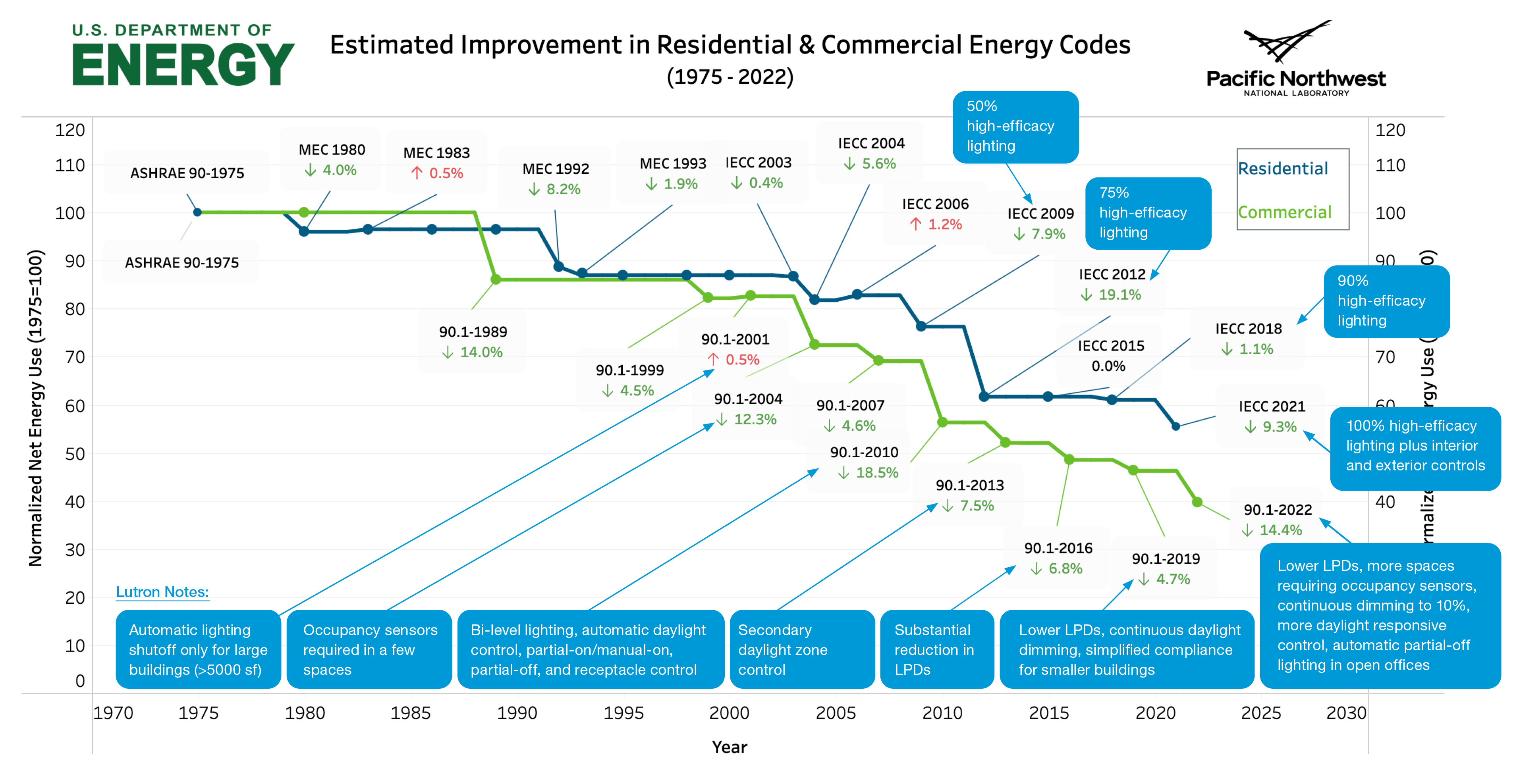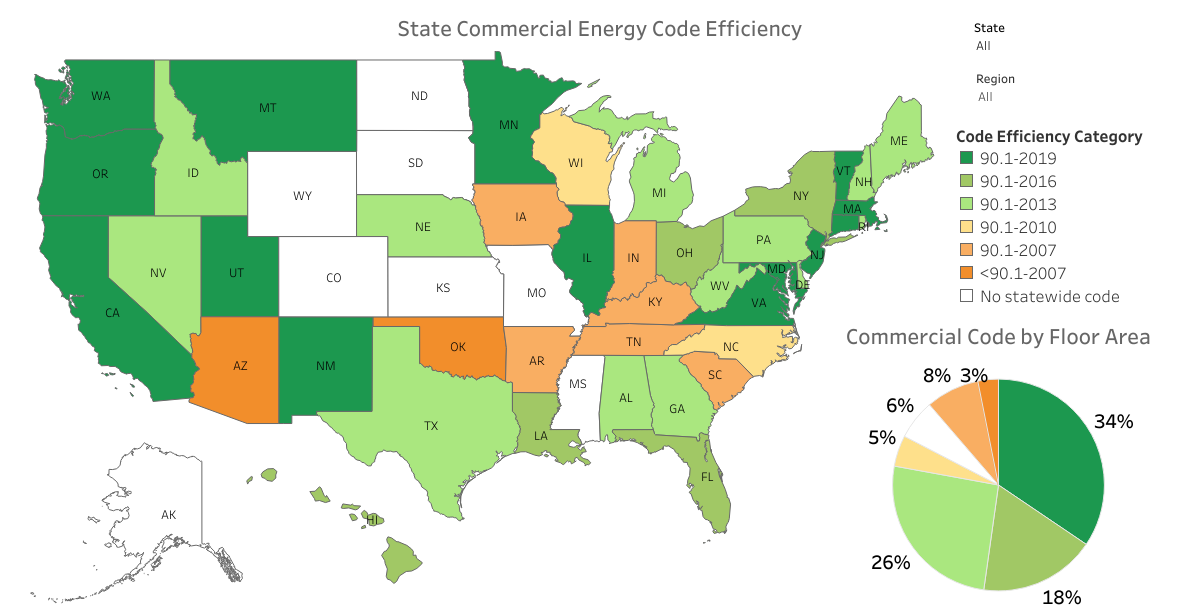Energy Code State of the Union
Updated October 2024
As the U.S. gears up for elections, it's a good time to review the state of energy codes. Building codes set construction standards to ensure safe living and working conditions, with energy codes focusing on boosting energy efficiency. North America's major energy codes include ASHRAE 90.1, IECC, Title 24 Part 6, and NECB.
Key Energy Codes
- IECC: Widely used in the U.S., forming the basis for most state energy codes.
- ASHRAE 90.1: Often an alternate to IECC, crucial for LEED projects. It covers commercial buildings and residential structures 4 stories and higher.
- Title 24 Part 6: Exclusive to California, this is seen as the most progressive code, often setting the trend for others.
- NECB: The standard for most Canadian provinces.
Code Updates
Codes are updated frequently – typically every 3 years – as new technologies, products, and strategies lead to greater opportunities for energy efficiency. According to the Department of Energy (DOE), a building designed to the minimum requirement of ASHRAE 90.1-2022 will be about 14% more energy efficient than one designed to 90.1-2019. Click here for details.

NOTE: Above graphic (source) outlines the estimated national average energy use reduction in model energy codes from 1975 to the present. Green down arrows indicate a more efficient code while red up arrows indicate lost efficiency from code to code. Data presented in this graph is based on total building energy use. Blue notes were added by Lutron to show key lighting and lighting control requirements that contributed to the increased energy efficiency. Click here to see the image larger.
×
The table below highlights the most current, published versions of each energy code. There is a lag between when a new version is published, and when it is adopted by the states or local jurisdictions. For instance, many states are still moving to IECC 2021, and some are still using IECC 2015 and moving to IECC 2018. Local jurisdictions (e.g., New York, NY and Seattle, WA) can choose to modify the state energy code to be more progressive and energy efficient than required by the state.
| Energy Code | Latest Version | Additional Information |
|---|---|---|
| IECC | 2024 | Published May 2024. |
| ASHRAE 90.1 | 2022 | |
| Title 24 Part 6 | 2022 | Title 24 2025 was adopted Sept 2024, effective Jan 1, 2026. |
| NECB | 2020 |
Adoption Trends
Adoption of updated energy codes varies by state and jurisdiction. There is a lag between when a new version is published, and when it is adopted by the states or local jurisdictions. For instance, many states are still moving to IECC 2021 (equivalent to 90.1-2019), and some are still using IECC 2015 (equivalent to 90.1-2013) and moving to IECC 2018 (equivalent to 90.1-2016). Local jurisdictions can choose to modify the state energy code to be more progressive and energy efficient than required by the state (e.g., New York, NY and Seattle, WA). Some states have no statewide energy code but jurisdictions within the state use different energy codes. Colorado, for instance, has an energy code required for Denver but a different energy code for Boulder.


The greener the state or province, the more progressive its energy code; orange states or provinces use older codes, while the white states are undecided and have mixed codes or no code at all. Source for U.S. map (click Commercial Portal tab), Data source used to make Canada map.
Future Projections
What’s on the horizon? Although we can’t be certain, here are some of the likely future provisions to anticipate. Consult your local code for current requirements.
- Demand-responsive lighting: More codes will require it, following Title 24’s lead.
- Automatic daylight responsive controls: Increased requirements for daylight responsive controls in spaces with windows/skylights.
- Continuous daylight dimming: Likely mandated, replacing less efficient daylight stepped switching.
- Dimmers: Expected to be required in certain spaces.
- Shorter occupancy sensor timeouts: From 20 to 15 minutes.
- Lower power allowances for decorative lighting.
Beyond lighting, anticipate more renewable energy, electric vehicle charging requirements, and energy storage requirements. Codes will also expand the energy credits requirements -- the point-based requirements for all projects. For instance, projects will have to achieve a certain number of additional energy efficiency measures to get the required number of points for their climate zone. Rather than dictate a specific strategy, projects will have a list of above-code energy efficiency measures to choose from and they must achieve some of them to meet the requirement.
- For lighting there are credits (points) for high-end trim of lighting, more occupancy sensor control, and lower lighting power allowances.
- Outside of lighting, there are energy credits for automated window shading, increased HVAC efficiency, and building envelope performance.
Final Thoughts
As we look at energy code trends, we can expect a continued focus on lighting control. Since LEDs are already so efficient, it is getting harder to reduce lighting power allowances without negatively affecting the occupant’s visual acuity. As a result, more lighting control requirements may be needed instead of lower lighting power.
All in all, North America’s energy codes are progressing, driving improvements in energy efficiency. Electrical engineers, architects, and lighting designers can navigate these changes by working with manufacturers to help with code-compliant designs and provide resources to make it easier to keep up with all the code changes in your area.
Michael Jouaneh is Manager of Sustainability and Energy Standards for Lutron.
Michael chaired the commercial Power, Lighting, and Renewables subcommittee for the 2024 International Energy Conservation Code (IECC). He is a vice chair of the ASHRAE 189.1 Standard for High-Performance Green Buildings committee and a voting member of the ASHRAE 90.1 Standard. He is active with many standards development organizations, including the California Energy Commission, National Electrical Manufacturers Association, and Illuminating Engineering Society.

